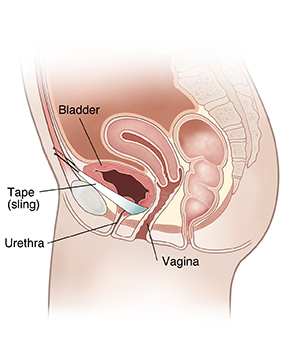Stress Urinary Incontinence: Having Pubovaginal Sling Surgery
To help treat stress urinary incontinence (SUI), your surgeon may do a procedure called pubovaginal sling surgery. A sling of tissue or mesh is placed like a hammock under the bladder and urethra. The sling helps support the bladder and urethra firmly in place. This helps keep the urethra closed to prevent urine leakage.
Your surgery will take about 2 hours. You will be asked to do some things at home to get ready for surgery. Below are guidelines to help you get ready. If you have any questions, call your nurse or doctor.

How should I get ready for surgery?
The weeks before surgery
-
Have any tests that your healthcare provider orders.
-
Tell your provider about aspirin and other medicines, vitamins, or herbs you take. Ask if you should stop taking them before surgery.
-
Stop smoking to help reduce your risks during and after surgery.
-
If you have been given any prescriptions to fill, do this before surgery.
The night before surgery
-
You may be asked to give yourself an enema. This cleans out your bowels for surgery. You’ll be told how to do it.
-
Follow any directions you are given for taking medicines.
-
Follow any directions you are given for not eating or drinking before surgery.
The day of surgery
Get to the hospital or surgical center a few hours before surgery as directed. Have someone drive you there who can also stay during the surgery, and drive you home.
You will be asked to read and sign a consent form. This gives your permission to do the surgery. Read the form carefully. Have all of your questions answered before you sign it.
Your temperature and blood pressure will be taken. In some cases, tests may be done. Then you will receive one or more IV (intravenous) lines. These lines give you fluids and medicines before, during, and after surgery.
Some of your pubic hair may be shaved. Tight stockings (compression stockings) may be put on your legs. This is to help prevent blood clots.
About anesthesia
To keep you pain-free during surgery, you’ll be given anesthesia. General anesthesia allows you to sleep. Regional anesthesia numbs the lower part of your body. Local anesthesia numbs the area that will be operated on. Before surgery, you’ll meet with the anesthesiologist or nurse anesthetist. They can tell you what kind of anesthesia you will have. They will answer questions you may have.
What happens during the procedure?
-
Two small cuts (incisions) are made in the lower belly (abdomen) near the pubic hairline. A small incision is also made in the front wall of the vagina.
-
If tissue from your body is used for the sling, it may be taken from your belly or thigh. If synthetic material or donor tissue is used, it's cut to the right size.
-
Working through the incisions, often right above the pubic hairline, the surgeon places the sling under the bladder and urethra. The ends of the sling are secured to strong tissues in your belly.
-
The incision in the belly is closed with stitches (sutures), staples, skin glue, or strips of tape. The vaginal incision is closed with stitches. Once this incision has healed, it should not cause you problems during sex.
What are the risks and possible complications?
All procedures have risks. Some risks of this procedure include:
-
Infection
-
Bleeding
-
Risks of anesthesia
-
Blood clots
-
Damage to nerves, muscles, bladder, or nearby pelvic tissues
-
Trouble urinating
-
Urinary urgency
-
The surgery doesn't reduce your symptoms
Online Medical Reviewer:
Donna Freeborn PhD CNM FNP
Online Medical Reviewer:
Marc Greenstein MD
Online Medical Reviewer:
Raymond Kent Turley BSN MSN RN
Date Last Reviewed:
3/1/2022
© 2000-2024 The StayWell Company, LLC. All rights reserved. This information is not intended as a substitute for professional medical care. Always follow your healthcare professional's instructions.